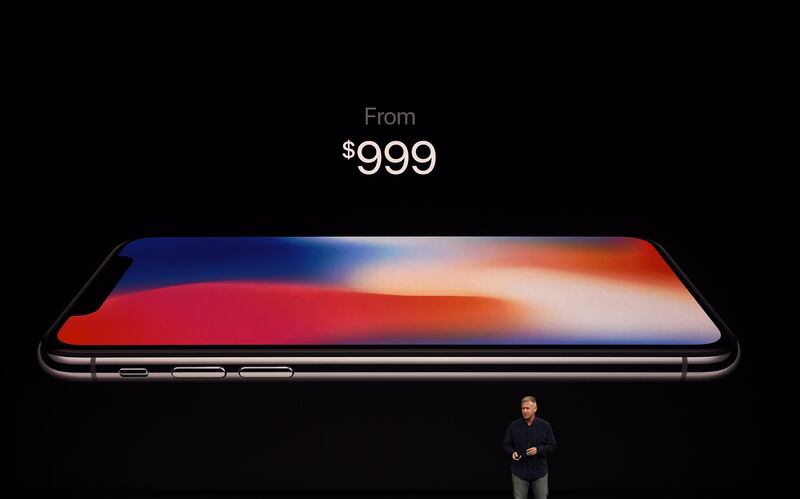Who's ready for a thousand-dollar iPhone? Answer: probably quite a lot of people. Millions are likely to buy Apple's new iPhone X when it ships in November, despite its base US$999 price tag in the US. In the UAE, it's set to be even more expensive, retailing from Dh4,099..
Many are also likely to buy the also-new and slightly less expensive iPhone 8, which goes on sale this month starting at the relative bargain price of $699.
But the fact that the new phones will almost certainly sell by the bucket load doesn't justify their astronomical price tags. Technology isn't supposed to work this way.
Gadgets are supposed to get cheaper as well as better over time , at least according to the celebrated Moore's Law, or Ray Kurzweil's Law of Accelerating Returns.
Every year, the logic goes, the components that make up smartphones and other gadgets – from processors and batteries to storage and screens – improve in quality and decline in cost.
Despite this phenomenon, Apple's signature bauble now sells for twice as much as it did when it was first introduced a decade ago.
_____________
Read more:
[ Apple iPhone X launch: facial-recognition and a brand new look ]
[ At what price will the UAE fall in love with the new iPhone X? ]
[ Comment: $999 for an iPhone X? Where do I sign? ]
_____________
A few factors explain why the iPhone has so far bucked the trend that otherwise applies to all other categories of electronic devices, such as laptops, tablets and televisions.
First up is the perceived value of a smartphone. For many people, it's the most important gadget they own – possibly even their most important possession over all. It's like a limb that connects us to the world and to each other.
Given this, what price a limb? Can all of the things that smartphones do for us and everything they enable us to do really be distilled into a simple monetary value?
If it were possible to come up with such an equation, it might be that a smartphone is actually worth well more than $1,000. The sky's the limit, really – and the same can't be said about laptops or televisions.
There's also the perceived value of the iPhone as a premium brand. There are plenty of cheaper smartphones that are arguably as good, or nearly as good, but Apple's device is still seen as king. Credit has to go to the company's marketing machine for that.
The biggest driver of price in the first iPhone decade, however, has been the method in which smartphones have been sold in markets such as Western Europe and the US, where wireless operators have subsidized the devices in exchange for customers signing onto multi-year service contracts.
Customers in such markets have received lower up-front prices for their smartphone, in exchange for the rest of the costs being amortized into monthly service bills over the length of their contracts.
With the iPhone’s true cost broken up and hidden in such a way, its hefty price tag has been out of sight, out of mind. That also doesn’t apply to tablets and TVs.
Apple and operators have benefited greatly from this arrangement. Estimates have pegged the company’s profit margin on the iPhone to be in the whopping 70-per-cent range. A number of analysts have declared it the most profitable product in history as a result.
Many operators in the US and Europe, meanwhile, have routinely posted margins in the 40- and 50-per-cent range. Oil giant Exxon Mobil, by way of comparison, only managed but a measly 5-per-cent margin in its most recent quarter. operators have supplied the veritable smokescreen for Apple’s continually climbing prices and have made a mint in the process.
So can anything be done about this never-ending iPhone-price inflation, which is also pulling up the prices competitors such as Samsung charge for their flagship phones? And more importantly, should anything be done?
Some countries have tried to take action. Finland and Belgium, for example, used to have rules that prohibited operators from subsidizing phones, but the results were mixed at best.
Both countries found uptake of advanced, expensive devices to be slow as consumers resisted paying big costs upfront. Adoption sped up dramatically after they changed the rules and allowed operators to bundle service with phones, in 2006 and 2010 respectively.
In the world of technology, that was an eternity ago. It might not be a bad idea to revisit such prohibitions now that smartphone use is widespread in most developed countries. The UAE for example leads the world in smartphone adoption with more than 80 per cent of the population on board.
Preventing operators from handling phones would expose more consumers to the full costs being charged by Apple and its competitors. They could balk and force prices down.
At the same time, there's some evidence that chafing is already happening. Prior to last week's new product unveilings, Chinese manufacturer Huawei – known for its lower cost devices – briefly beat out Apple to become the world's second-biggest maker by volume after Samsung, according to Counterpoint Technology Market Research.
While Huawei sells most of its phones in developing markets such as China and India, the momentum shows it is also making headway in advanced economies too. Its growth is proof that a growing segment of smartphone users around the world are starting to become more price conscious.
In light of that, the best thing to do about skyrocketing prices might actually be nothing. A few more years of market-share losses might convince Apple to try a different pricing strategy.






